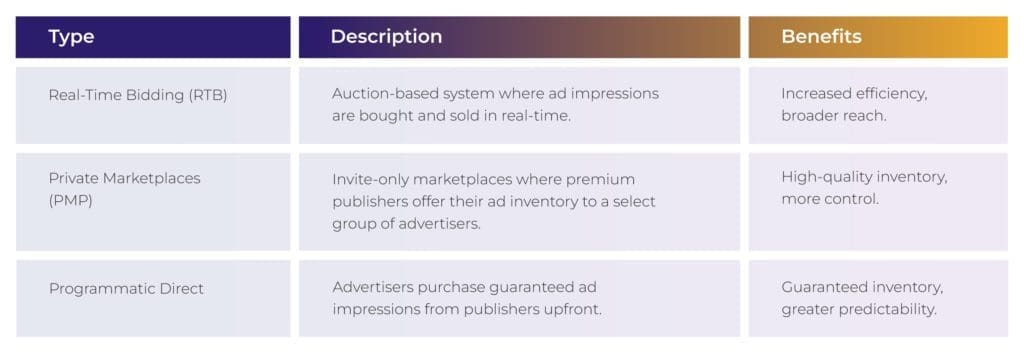Imagine being able to send a personal invitation to each of your customers, beckoning them into your store at the very moment they’re most inclined to shop. Sounds like a scene out of a science fiction movie? Not quite. Welcome to the cutting-edge world of mobile programmatic advertising – a realm where the impossible becomes possible, and where the Global Programmatic Advertising Market was estimated to be valued at $173.13 Billion in 2022. Getting your message across is no longer a game of shout and pray. Rather, it’s similar to being a skilled archer – one who meticulously crafts his arrow (the right message), keenly observes the wind direction (the right time), and then releases it with precision, aiming for the bullseye (the right person). This is the essence of mobile programmatic advertising, a trailblazing phenomenon that’s transforming the terrain of digital advertising.
Table of Contents
What is Mobile Programmatic Advertising?
Mobile programmatic advertising is the automated process of buying and selling ad spaces on mobile platforms. This approach leverages the power of data and sophisticated technology to make real-time decisions about which ads to display, to whom, and when. This strategy not only streamlines the advertising process but also significantly enhances its effectiveness. There are several types of mobile programmatic strategies that companies can utilize, each offering distinct levels of control, transparency, and access to inventory.
Types of Mobile Programmatic Solutions

The Advantages of Mobile Programmatic
When it comes to advertising, mobile programmatic offers several compelling benefits. One of the key benefits of mobile programmatic is the efficiency it provides. Rather than casting a wide, often wasteful net with traditional advertising methods, mobile programmatic targets users who are most likely to engage with your ads based on their behavior and demographics. This results in a significantly higher return on investment (ROI). Mobile programmatic also offers real-time optimization. You can track the performance of your ads in real-time and make necessary adjustments on the fly. This level of flexibility allows you to respond promptly to changes in user behavior or market conditions, enhancing the success of your campaigns. 

Exploring Mobile Programmatic Advertising Options
Mobile programmatic offers a variety of ad formats, each with unique advantages: Banner Ads: These are static or dynamic display ads that are placed on mobile websites or within mobile apps. Despite being one of the oldest forms of digital advertising, they remain popular due to their broad reach and simplicity. Video Ads: These are short, engaging video clips that can be played automatically or initiated by the user. Video ads are highly effective at capturing user attention and are perfect for storytelling. Native Ads: These ads are designed to match the look and feel of their surrounding content, making them less intrusive and more likely to be engaged with by users. 

Best Practices for Mobile Programmatic
Consider this: You’ve just bought a high-end, top-of-the-line sports car. It’s a beast, packed with power and precision, but without the right knowledge, you won’t be able to push it beyond a simple drive around the block. It’s a bit like mobile programmatic advertising. An incredible advertising method, but to truly unlock its full potential and let it roar on the digital highway, you need to adhere to certain best practices. So, let’s jump into the driver’s seat, fasten our seat belts, and get ready to explore the best practices in mobile programmatic advertising. These essential rules of the road will ensure you’re navigating the scenario in the most effective way, squeezing every last drop of value from your campaigns.
- Understand Your Audience: The first step to a successful mobile programmatic campaign is to have a clear understanding of your target audience. Use data analytics to understand their behaviors, preferences, and habits. This will allow you to create more targeted and personalized ads that resonate with your audience.
- Leverage Data and Technology: The use of data and technology is integral to mobile programmatic. Utilize real-time bidding (RTB) technologies to automate the buying and selling process. Leverage data management platforms (DMPs) to collect, analyze, and manage data from various sources. Use this data to inform your campaign strategy and make real-time adjustments to optimize performance.
- Opt for Rich Media Ads: Rich media ads, such as video and interactive content, have been shown to generate higher engagement rates than traditional banner ads. They provide a more immersive experience, which can lead to better brand recall and higher conversion rates.
- Ensure Brand Safety and Viewability: Ad fraud and viewability are significant challenges in the programmatic space. Use tools and partnerships with digital ad verification companies to ensure your ads are being viewed by real people and are appearing alongside appropriate and relevant content.
- Measure and Optimize: Continuously measure the performance of your campaigns using key metrics like click-through rates (CTR), conversion rates, and return on ad spend (ROAS). Make necessary adjustments to your strategy based on these insights to optimize performance.
- Keep Abreast of Industry Changes: The mobile programmatic landscape is constantly evolving. Stay updated with the latest trends, technologies, and regulations to ensure your campaigns remain effective and compliant.
Here is a hypothetical example:
A startup company in the fitness industry decides to leverage mobile programmatic advertising to promote its new fitness app. They use a DMP (Data Management Platform) to understand their target audience’s habits and preferences – such as their preferred workout times and types of exercises. They create personalized video ads that resonate with this audience and use RTB (Real Time Bidding) technologies to automate their ad-buying process.
Also, they partner with a digital ad verification company to ensure brand safety and viewability. Through continuous measurement and optimization, they are able to increase their app downloads and user engagement significantly.
By following best practices, businesses can significantly enhance their mobile programmatic advertising strategies achieving better engagement, higher conversions, and a stronger ROI.
Navigating the Challenges with Mobile Programmatic Advertising
Despite its many advantages, mobile programmatic is not without its challenges. Ad fraud, where fraudulent bots mimic human behavior to generate fake clicks, and viewability, ensuring that ads are properly displayed and seen by users, are two significant concerns. However, the industry is constantly developing solutions to these problems. For instance, the use of advanced technology and partnerships with digital ad verification companies are helping to mitigate ad fraud and ensure brand safety. Marketers also increasingly rely on incrementality measurements to evaluate the success of their programmatic ad buying efforts. By understanding if a particular ad convinces a user to convert or if the user was likely to convert anyway, marketers can reallocate their budget to campaigns with high incrementality, thereby reducing wasted ad spend and optimizing overall performance. Frequency capping is another solution that addresses the challenge of ad overexposure. By controlling how many times an ad appears in front of a user on any given day, brands can strike a balance between maintaining strong awareness and avoiding user annoyance. This approach not only enhances the user experience but also positively impacts consumer purchase decisions and improves return on ad spend (ROAS).
- Ad Fraud: Fraudulent activities have become a significant issue in the programmatic advertising space. Despite the industry’s efforts to combat these fraudulent activities, it remains a persistent challenge.
- Privacy Concerns: The privacy landscape is continuously changing, with consumers becoming more concerned about their data privacy. This has led to a need for more transparent practices in the handling of personal data.
- Fragmented Ecosystem: The programmatic ecosystem is complex and fragmented, making it difficult for advertisers to keep up with the changes.
- Data Management: The sheer volume of data generated from programmatic advertising campaigns can be overwhelming. The challenge lies in effectively analyzing and interpreting this data to optimize ad performance.
Looking Ahead: The Future of Mobile Programmatic
The future of mobile programmatic is promising, with continuous advancements in technology and data analysis. The integration of artificial intelligence (AI) and machine learning (ML) is expected to further refine targeting capabilities and optimize ad performance. As programmatic platforms become increasingly sophisticated, they will offer even greater personalization, scalability, and accurate measurement, thereby expanding audience reach and optimizing strategy in real-time1.
To summarize understand the Power of Mobile Programmatic
Mobile programmatic advertising presents an exciting opportunity for app founders and CMOs of startups. Since it is similar to a high-performance engine, but even the most advanced engine requires a skilled driver. Our Performance Marketing Director, Pablo Perez’s insights are that
“The human factor plays a crucial role in harnessing the full potential of mobile programmatic. From strategy to setup, and from measurement to optimization – the understanding, creativity, and critical thinking that humans bring to the table are indispensable. It’s about turning data into actionable insights for the marketer for a better decision-making process.” He also affirms that “the integration of human insights with technology helps in creating campaigns that not only reach the right people but also connect with them on a deeper level. In the evolving scene of mobile programmatic, let’s not forget that at the end of every click, there’s a human being.”
As a mobile marketing agency is here to guide you through the complexities of mobile programmatic advertising. With our expertise and dedication, we can help you leverage this powerful tool to achieve your business goals. Contact us today, and let’s take your mobile advertising strategy to the next level.





